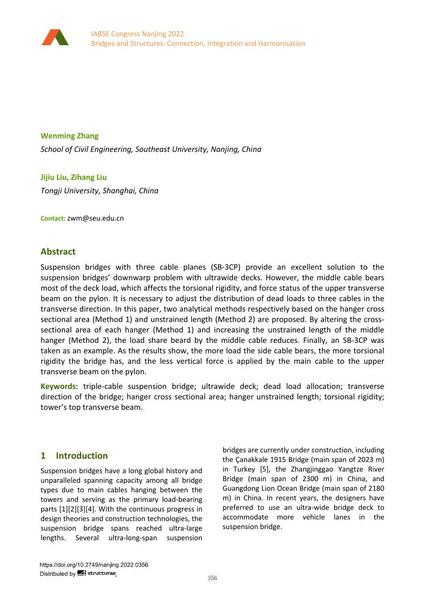Analytical Methods to Adjust the Distribution of Dead Loads of a Suspension Bridge with Three Cable Planes to Three Cables in The Transverse Direction

|
|
|||||||||||
Bibliographic Details
| Author(s): |
Wenming Zhang
(School of Civil Engineering, Southeast University, Nanjing, China)
Jijiu Liu (Tongji University, Shanghai, China) Zihang Liu (Tongji University, Shanghai, China) |
||||
|---|---|---|---|---|---|
| Medium: | conference paper | ||||
| Language(s): | English | ||||
| Conference: | IABSE Congress: Bridges and Structures: Connection, Integration and Harmonisation, Nanjing, People's Republic of China, 21-23 September 2022 | ||||
| Published in: | IABSE Congress Nanjing 2022 | ||||
|
|||||
| Page(s): | 356-363 | ||||
| Total no. of pages: | 8 | ||||
| DOI: | 10.2749/nanjing.2022.0356 | ||||
| Abstract: |
Suspension bridges with three cable planes (SB-3CP) provide an excellent solution to the suspension bridges’ downwarp problem with ultrawide decks. However, the middle cable bears most of the deck load, which affects the torsional rigidity, and force status of the upper transverse beam on the pylon. It is necessary to adjust the distribution of dead loads to three cables in the transverse direction. In this paper, two analytical methods respectively based on the hanger cross sectional area (Method 1) and unstrained length (Method 2) are proposed. By altering the cross- sectional area of each hanger (Method 1) and increasing the unstrained length of the middle hanger (Method 2), the load share beard by the middle cable reduces. Finally, an SB-3CP was taken as an example. As the results show, the more load the side cable bears, the more torsional rigidity the bridge has, and the less vertical force is applied by the main cable to the upper transverse beam on the pylon. |
||||
| Keywords: |
torsional rigidity triple-cable suspension bridge ultrawide deck dead load allocation transverse direction of the bridge hanger cross sectional area hanger unstrained length tower’s top transverse beam
|
||||
| Copyright: | © 2022 International Association for Bridge and Structural Engineering (IABSE) | ||||
| License: | This creative work is copyrighted material and may not be used without explicit approval by the author and/or copyright owner. |
||||

